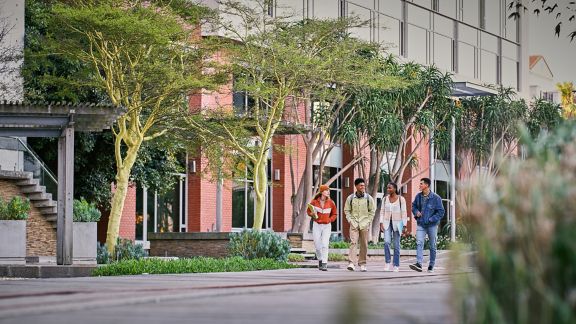Unlocking Hearts & Minds: The Transformative Power of AI-Enhanced High-Dose Tutoring

Authors
March 2024
The White House recently announced the “Improving Student Achievement Agenda for 2024,” a detailed plan to enhance student achievement nationwide using evidence-based strategies (The White House, 2024). Among these, high-dose tutoring has emerged as a promising approach, attracting significant interest from many leading educational institutions and national think tanks (Guryan & Ludwig, 2023; Cohen, 2024; Hamilton & Kim, 2021).
But what exactly is high-dose tutoring, and why is it becoming so popular?
Think of it as intense, personalized instruction delivered frequently (at least three 30-minute sessions per week) in small groups (1-4 students) during the school day. Decades of research shows that high-dose tutoring can dramatically improve students’ learning outcomes, increase school attendance (Fryer & Howard-Noveck, 2020), and help students achieve reading proficiency (Kortecamp & Peters, 2023).
However, implementing high-dose tutoring presents some challenges. First, that kind of one-on-one intensive tutoring is expensive, making it inaccessible to students with financial constraints. Second, high-dose tutoring is difficult to scale due to the number of tutors needed and the logistical support necessary. These logistical and financial challenges create an uneven playing field.
Some of these are decade-long challenges, but this is exactly where artificial intelligence (AI) comes into play. Recent advancements in intelligent educational systems and AI present efficient and scalable solutions to overcome them (Aleven et al., 2023; Holstein et al., 2020).
The Promise of AI Tutoring
AI-enhanced tutoring systems provide a transformative approach that could completely change how we learn and develop skills. These systems combine advanced algorithms and statistics with personalized and timely feedback to adapt to individual learning needs in real time (D’Mello & Graesser, 2023).
Now, imagine a scenario where a high school student struggles with advanced calculus. In this scenario, a human tutor and an AI-enhanced tutoring system collaborate to support the student’s learning experience. The AI system analyzes the student’s interactions with the material, examines the student’s emotions, evaluates challenging areas, and develops a personalized learning plan. As the student progresses, the AI provides real-time feedback, adapts dynamically, and uses diverse teaching methods to align with the student’s unique learning style.
In the meantime, the human tutor receives all these insights from the AI and strategically provides extra guidance, encouragement, and a personal touch to enhance the learning process. This collaborative effort ensures that the student receives a personalized, adaptive, and comprehensive learning experience while allowing the human tutor to serve a higher caseload of students. Together, they create a powerful, personalized, and time-efficient learning experience for students.
The Momentum of Intelligent Tutoring Systems
The intelligent tutoring systems field is expanding, and many new systems are starting to integrate different AI functionalities, such as real-time feedback loops and gamification elements, into educational systems. For example, Carnegie Learning recently announced LiveHint AI, a math tutor built on a large language model to help middle and high school students. This intelligent tutoring system is based on data collected from 5.5 million students working on over 1.2 billion math problems in the last 25 years. Similarly, Khan Academy has developed an AI-powered tutoring system called Khanmigo that provides personalized feedback and support to students as they work through Khan Academy’s exercises. DreamBox, EduBot, Cognii, and many other intelligent educational systems use advanced algorithms that adjust content based on students’ progress and comprehension to support their math and reading skills.
These innovative platforms are already transforming the learning experiences for millions of students, and this is just the tip of the iceberg. We are in the era of intelligent educational systems, and the ongoing trend suggests that the popularity of AI-enhanced tutoring is expected to evolve further.
Breaking Down Barriers with Scalable Solutions
AI systems can handle many students simultaneously and overcome the limitations of traditional human-intensive tutoring models. Integrating AI into high-dose tutoring can help ensure that personalization reaches every student, and educators can efficiently tailor educational experiences to the diverse needs of a large student body. With an AI-enhanced high-dose tutoring model, every student can access their own virtual tutor that adapts to their pace, understands their strengths and weaknesses, and provides targeted support. This allows personalized learning to be more accessible.
This AI-enhanced model moves us from the traditional “one-size-fits-all” instruction to a new “one-size-fits-one” approach that can be broadly implemented. Another major benefit of infusing AI into high-dose tutoring is its power to break down geographical and economic barriers. Students from all corners of the globe can access high-quality education, leveling the playing field and democratizing learning opportunities. This is a game-changer, especially for students who may not have had access to these resources before.
Collaborative Synergy between Teachers and AI
Contrary to concerns that AI might replace teachers, integrating AI in education is designed to enhance, not replace, human interaction. Teachers leverage AI-derived insights to adjust their instructional methodologies, fostering a more effective and adaptive pedagogical approach. In this innovative approach, AI serves as a tool for educators, providing personalized insights and adapting teaching strategies in real time. This dynamic interaction streamlines the teaching process and fosters a more engaging learning environment (Chine et al., 2022).
The Road Ahead
Integration of AI into education is no longer a matter of “if” but “how.” Many challenges, including ethical considerations, still need attention. However, the potential benefits far outweigh the challenges, and the road ahead demands collaboration among educators, policymakers, and technologists to create a harmonious integration of AI into the classroom. Together, we must work towards a future where scalable, intelligent tutoring systems elevate the learning experience for students and empower educators with the tools they need to foster a dynamic educational environment in our public schools. The journey may be challenging, but with a collaborative and thoughtful approach, scalable AI-enhanced high-dose tutoring systems hold the key to addressing the gaps in traditional education models, ensuring that every student receives tailored support, irrespective of their learning pace and style.
References
- The White House. (2024, January 17). FACT SHEET: Biden-Harris Administration Announces Improving Student Achievement Agenda in 2024. https://www.whitehouse.gov/briefing-room/statements-releases/2024/01/17/fact-sheet-biden-harris-administration-announces-improving-student-achievement-agenda-in-2024/.
- Guryan, J., & Ludwig, J. (2023). Overcoming pandemic-induced learning loss. In Building a More Resilient US Economy (pp. 150-173). Aspen Institute. https://www.economicstrategygroup.org/wp-content/uploads/2023/11/Guryan_Ludwig_2023_Chapter.pdf
- Cohen, L. (2024). Learning curve: lessons from the tutoring revolution in public education. FutureEd. https://www.future-ed.org/wp-content/uploads/2024/01/Learning-Curve-Lessons-from-the-Tutoring-Revolution-in-Public-Education.pdf
- Hamilton, J., & Kim, D. (2021). The promise of a virtual math tutoring program for urban high school students: Results from a beleaguered RCT (for the College Board). Chicago, IL: NORC.
- Fryer Jr, R. G., & Howard-Noveck, M. (2020). High-dosage tutoring and reading achievement: evidence from New York City. Journal of Labor Economics, 38(2), 421-452.
- Kortecamp, K., & Peters, M. L. (2023). The Impact of a High-Dosage Tutoring Program on Reading Achievement of Beginning Readers: A Multi-Level Analysis. Journal of Education for Students Placed at Risk (JESPAR), 1-19.
- Aleven, V., Baraniuk, R., Brunskill, E., Crossley, S., Demszky, D., Fancsali, S., ... & Xing, W. (2023). Towards the Future of AI-Augmented Human Tutoring in Math Learning. In International Conference on Artificial Intelligence in Education (pp. 26-31).
- Holstein, K., Aleven, V., & Rummel, N. (2020). A conceptual framework for human–AI hybrid adaptivity in education. In Artificial Intelligence in Education: 21st International Conference, AIED 2020, Ifrane, Morocco, July 6–10, 2020, Proceedings, Part I 21 (pp. 240-254).
- D'Mello, S. K., & Graesser, A. (2023). Intelligent tutoring systems: How computers achieve learning gains that rival human tutors. In Handbook of educational psychology (pp. 603-629). Routledge.
- Chine, D. R., Brentley, C., Thomas-Browne, C., Richey, J. E., Gul, A., Carvalho, P. F., ... & Koedinger, K. R. (2022). Educational equity through combined human-AI personalization: A propensity matching evaluation. In International Conference on Artificial Intelligence in Education (pp. 366-377).
Citation
Celepkolu, M., & Hamilton, J. (2024, MONTH DAY). Unlocking Hearts and Minds: The Transformative Power of AI-Enhanced High-Dose Tutoring. NORC at the University of Chicago. Retrieved from https://www.norc.org.






